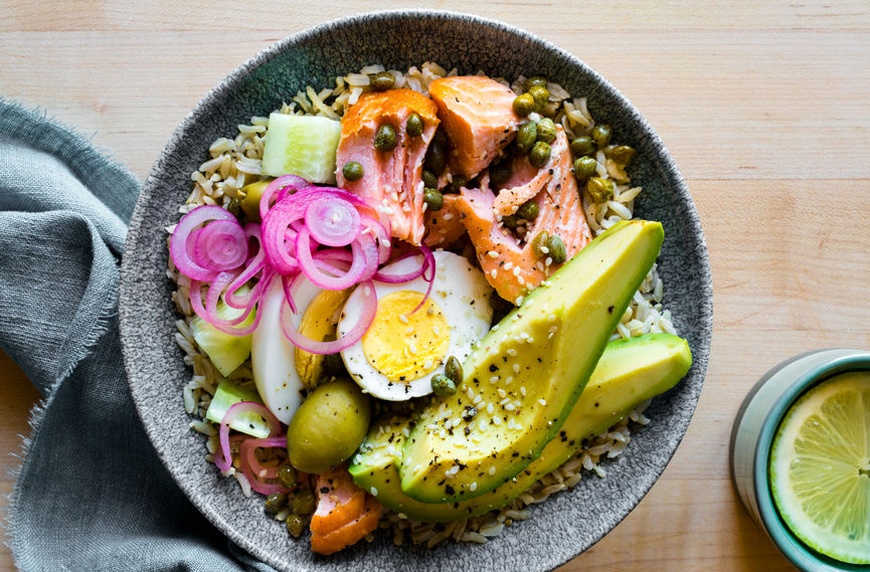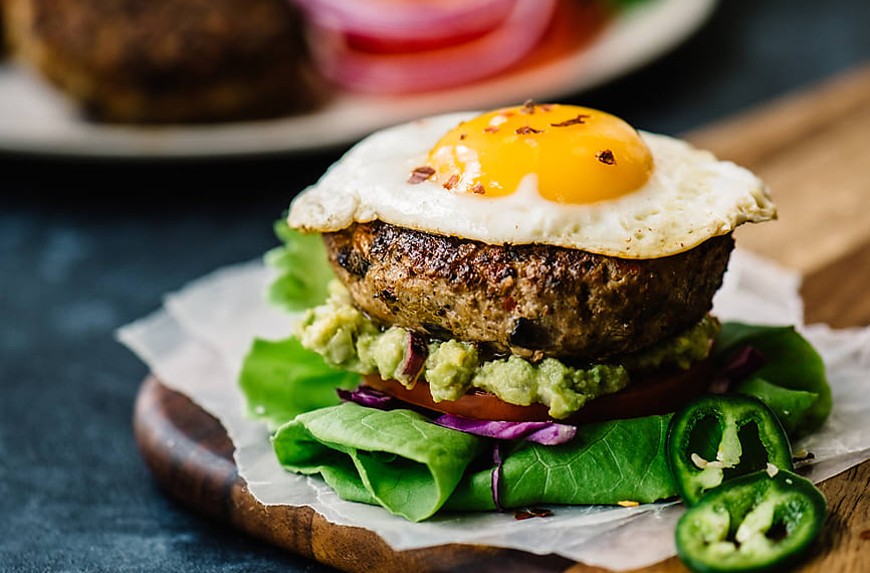How To Get More Vitamin B
We've all had one of those days—the kind where you feel drowsy and depleted, your memory is shot, and you can't focus on your work for more than a minute before your mind wanders off to a happier place. And while this is totally normal if you've stayed up too late listening to podcasts (they're addictive, okay?), sometimes a string of off weeks can hit without an obvious cause. If that's the case, you might want to start by taking a closer look at your diet, specifically zooming in on your B vitamin intake.
Why? Well, with eight B vitamins performing critical roles in the body—from production of hormones, neurotransmitters, and red blood cells to conversion of food to energy—it's no wonder we feel the impact when we aren't meeting our daily quota.
Luckily, if you and your doctor suspect this might be at the root of your problems, the fix is fairly simple: A healthy, balanced diet is the best way to ensure adequate B vitamin intake. According to Rachel Gargiulo, a certified nutrition consultant, the full range of B vitamins "can be acquired through a range of food choices, mostly coming from animal sources. So to maximize your intake of these essential nutrients, aim to eat a variety of animal products, such as beef, chicken, eggs, lamb, turkey, tuna, salmon, and sardines."
Related Stories

And what if your kitchen's a meat-free zone? Though it is possible to acquire most of the B vitamins through plant-based dietary sources—including soy, nuts, seeds, whole grains, leafy greens, avocado, and beans—Gargiulo cautions that these "aren't as readily absorbed into the body." So it's also recommended that vegans and vegetarians consider adding vitamin B-fortified foods, such as cereals, non-dairy milk, and nutritional yeast, to their dietary repertoires.
That's the short version. But if you want to get your PhD in all things B, read on for a breakdown of the eight essential B vitamins, including intel about their unique jobs in the body, foods in which they're most readily available, recommended daily intake, and symptoms of deficiency. Who knows—more energy and better concentration could be a matter of simply tweaking your grocery list.
Scroll down for a list of B vitamin-rich foods everyone should have in their diets.

B vitamins from A to Z: A beginner's guide
Okay, first things first: Consult your doctor if you're concerned about the possibility of B vitamin deficiency. Through a simple blood test, she'll be able to pinpoint exactly which nutrients you're lacking (if any), which will help you get to the root of the problem as quickly and safely as possible.
Armed with that information, you can use this guide to learn more about any B vitamins you need to get more of—again, whole foods are best for many, but your doctor may recommend supplementing, depending on your unique needs.
1. Vitamin B1 – Thiamine
Thiamine is responsible for turning carbs into energy, as well as improving brain, muscle, and nervous system health and function.
Foods high in thiamine: Thiamine is found in high concentrations in fortified cereals, enriched whole grain products (like brown rice), black beans, pork, trout, mussels, and tuna. Note that heating foods may reduce their thiamine content.
Daily dosage: According to the RDAs (Recommended Dietary Allowances) from the Institute of Medicine (IOM) of the National Academy of Sciences, adult men should aim for 1.2 mg of thiamine, while adult women need 1.1 mg and pregnant or lactating women need 1.4 mg.
Symptoms of deficiency: People who don't consume enough thiamine may experience poor appetite, weight loss, confusion, memory loss, muscle weakness, or cardiovascular symptoms.
2. Vitamin B2 – Riboflavin
Riboflavin helps the body use other B vitamins, converts food into fuel, and assists with red blood cell production and growth.
Foods high in riboflavin: Riboflavin is present naturally in eggs, organ meat, lean meats, milk, and green vegetables. It's also found in fortified cereals and enriched whole grain products.
Daily dosage: Men need 1.3 mg of riboflavin; women should consume 1.1 mg, though it's recommended that pregnant women aim for 1.4 mg and those breastfeeding should try to consume 1.6 mg.
Symptoms of deficiency: Inadequate intake of riboflavin may lead to skin conditions, mouth sores, cracked and swollen lips, hair loss, sore throat, liver disorders, problems with the reproductive and nervous systems, and, in severe cases, anemia or cataracts.
3. Vitamin B3 – Niacin
Niacin is essential to healthy digestive system function. It also aids in the production of hormones, as well as skin and nerve functioning, and assists with the conversion of food to energy.
Foods high in niacin: Your best bet for boosting niacin intake is to eat foods such as eggs, fish, lean meats, poultry, peanuts, dairy products, rice, fortified cereals, and enriched bread.
Daily dosage: It's recommended that men consume 16 mg of niacin, while women should aim for 14 mg. Pregnant women need 18 mg and those who are lactating need 17 mg. Just be sure not to go over 35 mg per day, as large doses can cause increased blood sugar, liver damage, peptic ulcers, and skin rashes.
Symptoms of deficiency: Niacin deficiency may show up in the form of confusion and mental impairment, digestive problems, inflamed mucous membranes, and scaly skin sores.
4. Vitamin B5 – Pantothenic Acid
Pantothenic acid is responsible for breaking down fats and carbs for energy, as well as producing red blood cells and cholesterol. It also assists the body in using other vitamins, such as riboflavin.
Food high in pantothenic acid: The best dietary sources of pantothenic acid include beef, poultry, seafood, organ meats, eggs, milk, shiitake mushrooms, avocados, potatoes, broccoli, whole grains (brown rice, oats), peanuts, sunflower seeds, and chickpeas.
Daily dosage: Adults should consume 5 mg of pantothenic acid, though pregnant women need 6 mg and lactating women should aim for 7 mg.
Symptoms of deficiency: Fortunately, pantothenic acid deficiency is rare. Those who do suffer from it may experience numb or burning hands and feet, extreme fatigue, headache, irritability, restlessness, sleeping problems, digestive problems, and loss of appetite.

5. Vitamin B6 – Pyridoxine
Pyriodoxine (more commonly referred to as vitamin B6) is critical for over 100 enzyme reactions required for metabolism. It's also necessary for healthy brain development during pregnancy and infancy, and it plays a role in immune function and helping to use and store energy.
Food high in vitamin B6: Vitamin B6 is found in fruits (other than citrus), starchy vegetables like potatoes, poultry, fish, organ meats, and fortified cereals.
Daily dosage: If you're an adult under 50, an RDA of 1.3 mg of vitamin B6 is recommended. Men over 50 should bump it up to 1.7 mg and women in the same age group should aim for 1.5 mg. Pregnant women should consume 1.9 mg and lactating women need the most, at 2mg. Although it would be hard to exceed 100mg per day, avoid doing so in the long term—it's been associated with severe nerve damage, painful skin patches, sensitivity to sunlight, nausea, and heartburn.
Symptoms of deficiency: Vitamin B6 deficiency is uncommon, but symptoms such as anemia, skin rashes, scaly skin around the lips, cracks at the corner of the mouth, swollen tongue, depression, confusion, and weak immune system may be indicative of it.
6. Vitamin B7 – Biotin
Biotin is best known for promoting healthy hair, skin, and nails—biotin supplements are a staple in the beauty world—but it's also used by the body to metabolize food for energy.
Foods high in biotin: The best dietary sources of biotin include beef, pork, organ meat, egg yolks, wheat germ, sunflower seeds, sweet potatoes, almonds, whole grains, sardines, spinach, and broccoli.
Daily dosage: Adults should aim to consume 30 mcg of biotin; if you're lactating, increase your intake to 35 mcg.
Symptoms of deficiency: Biotin deficiency is super rare, but symptoms include hair loss, brittle nails, skin rashes or infections, pinkeye, high acid levels in the blood and urine, seizures, and nervous system disorders.
7. Vitamin B9 – Folate
As every pregnant woman knows, folate is a non-negotiable part of your diet—when you're growing a human, it's essential for DNA synthesis and the production of other genetic material. It also reduces the risk of severe birth defects in the nervous system, such as spina bifida. (Oh, and the rest of us need it, too—for red blood cell production, among other things.)
Foods high in folate: Folate occurs naturally in foods such as asparagus, Brussels sprouts, dark green leafy vegetables, fruits and fruit juices (especially orange juice), nuts, beans, and peas. A form of folate called folic acid is used in dietary supplements and fortified foods, such as cereals, enriched flour products, and rice.
Daily dosage: Adults should aim for 400 mcg of folic acid, while pregnant women should increase to 600 mcg and lactating women should consume 500 mcg. An upper limit of 1,000 mcg per day has been established for folate, as folic acid supplementation exceeding this amount may mask a vitamin B12 deficiency, potentially resulting in permanent nerve damage, and may also increase the risk of certain cancers.
Symptoms of deficiency: Groups that are vulnerable to folate deficiency include women aged 14-30 years old (especially before and during pregnancy), non-Hispanic black women, people with disorders that lower nutrient absorption (e.g., celiac disease, inflammatory bowel disease), and people with alcoholism.
Symptoms of folate deficiency include sores on the mouth and tongue, diarrhea, gingivitis, poor growth, and color changes to the skin, nails, or hair. Folate deficiency may result in anemia, while pregnant women who don't get enough folate have a higher risk of premature delivery and giving birth to babies with neural tube defects and low birth weight.
8. Vitamin B12 – Cobalamin
Cobalamin (more commonly referred to as vitamin B12) has several VIP functions in the body. It ensures the health of the nervous system and red blood cells, metabolizes proteins, and synthesizes DNA, to name just a few.
Foods high in vitamin B12: Vitamin B12 does not occur naturally in any plant-based foods. It's concentrated in animal products such as beef liver, clams, fish, poultry, eggs, and milk. Some cereals and nutritional yeasts are fortified with vitamin B12.
Daily dosage: Adults should get 2.4 mcg of vitamin B12 per day. Pregnant women should up their dosage to 2.6 mcg and lactating women should further increase to 2.8 mcg.
Symptoms of deficiency: There are several groups that are at increased risk for vitamin B12 deficiency: Older adults, people with pernicious anemia, people who have undergone gastrointestinal surgery or who have digestive disorders, vegetarians, and vegans. Signs of inadequate vitamin B12 intake include weakness, fatigue, tingling in hands and feet, digestive problems, loss of appetite, mouth ulcers, shortness of breath, dizziness, depression, mood swings, decline in cognition and memory, pale skin, and ringing in the ears.
For most of us, the takeaway message here is that a diet consisting of fruits, vegetables, meat, dairy, rice, beans, nuts, seeds, and fortified whole grain products will give you the best vitamin B bang for your buck. Supplementation might be helpful in some cases, but most people can meet their vitamin B needs through diet alone. And you know what that means—more cash for your leggings budget.
Originally published September 5, 2018. Updated September 23, 2019.
Spirulina's another (vegan!) B vitamin powerhouse—here are three recipes using the algae of the moment. And if you don't eat meat, you should also consider these supplements doctors recommend for plant-based eaters.
How To Get More Vitamin B
Source: https://www.wellandgood.com/foods-high-in-b-vitamins/
Posted by: martinezager1981.blogspot.com

0 Response to "How To Get More Vitamin B"
Post a Comment